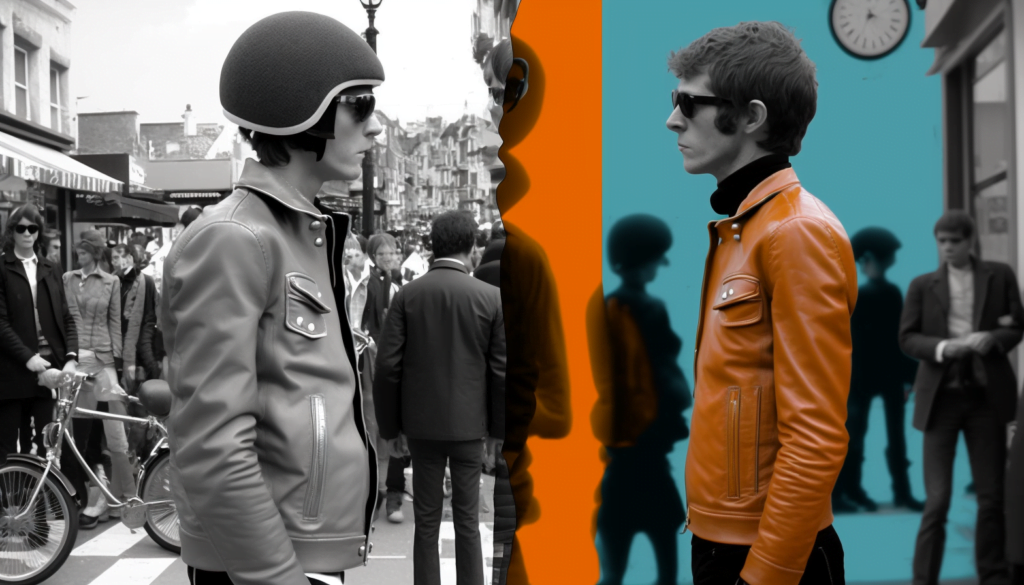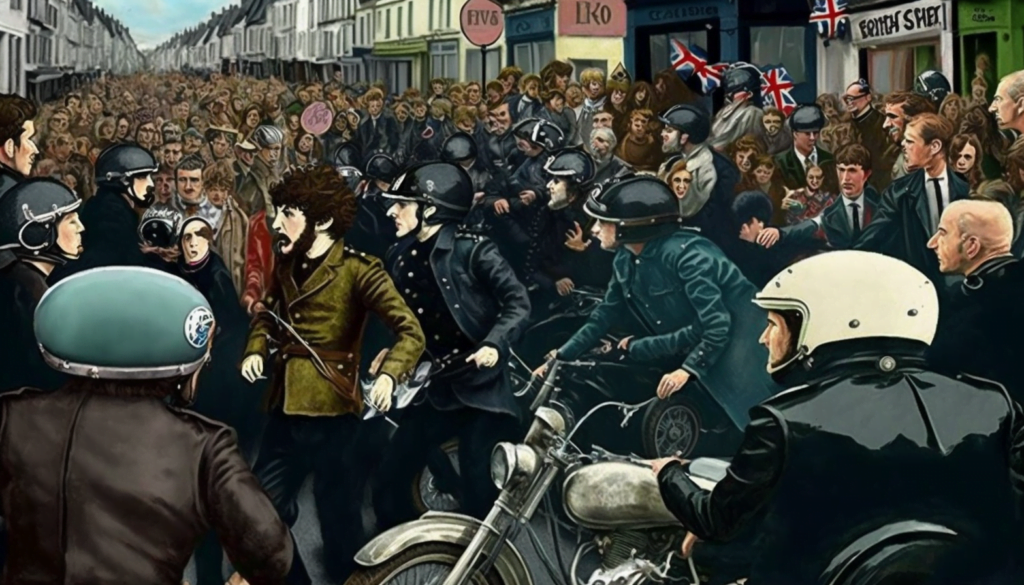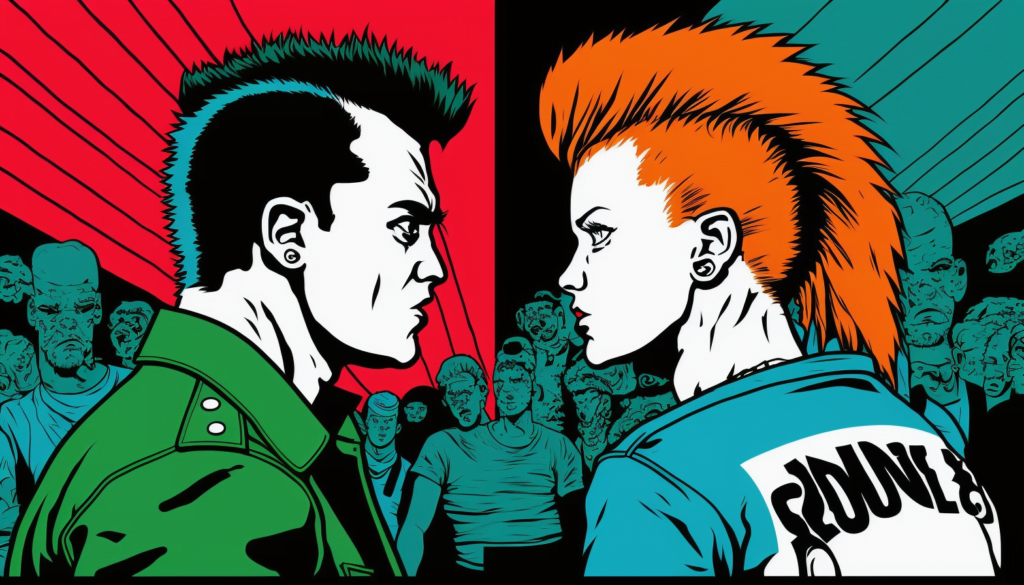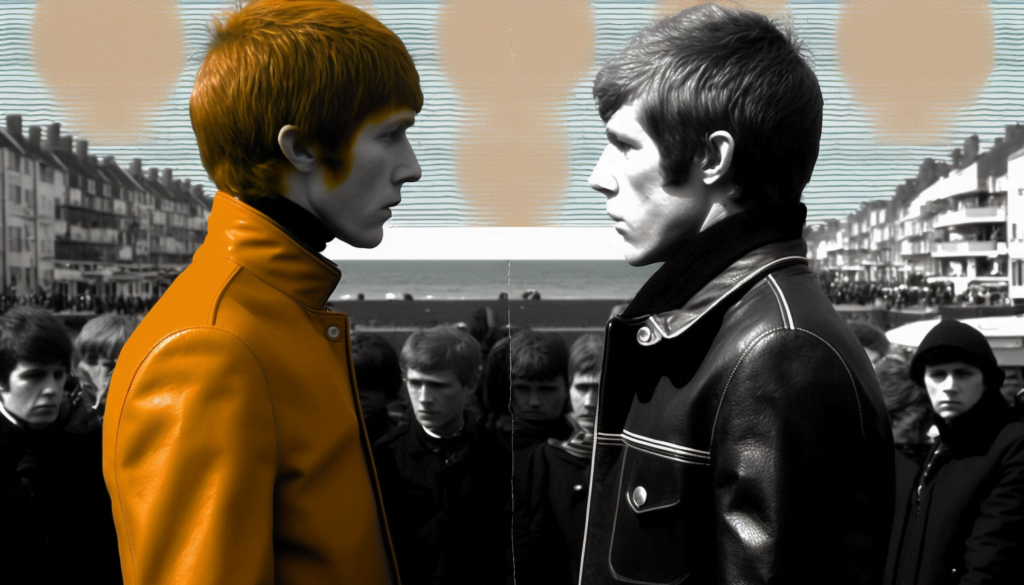
The early 1960s were a time of moral panic in the UK. Clashes and conflicts between two youth subcultures – the mods and the rockers – shocked the country and grabbed the attention of the media.
The mods were a subculture that originated in the late 1950s and were characterized by their fashion, music, and lifestyle. They were often seen as fashion-conscious, middle-class youth who loved American soul and R&B music. The mods were known for their sharp suits, skinny ties, and Vespa or Lambretta scooters.
On the other hand, the rockers were a subculture that emerged in the 1950s and were characterized by their love of rock and roll music, motorcycles, and leather jackets. Rockers were often seen as working-class, rebellious youth who preferred a more rough-and-tumble lifestyle.


As the mods and rockers grew in numbers and influence, their paths began to cross. It was in seaside towns such as Brighton, Margate, and Clacton-on-Sea that the two groups would clash in a series of violent incidents that shocked the country.
The media coverage of these clashes only served to fuel the moral panic, as headlines screamed about the “wild behavior” of these young people, and the “threat” that they posed to society. The coverage of these incidents served to amplify the sense of moral panic and hysteria that surrounded the conflict between the mods and the rockers.
The British government responded with new laws aimed at curbing the behavior of young people. The Public Order Act 1936 gave police more powers to arrest people for “breach of the peace.” But despite these efforts, the clashes continued.
Over time, the conflicts between the mods and the rockers began to dissipate. The two subcultures drifted apart, and new youth movements emerged to take their place. Despite the violence and chaos of the early 1960s, the mods and rockers have become iconic symbols of 1960s youth culture.
Stray Cats’ hit song “Rumble in Brighton.”

While the real-life conflicts between the mods and rockers were serious and often violent, they also captured the imagination of popular culture. The imagined fight between the two subcultures in the seaside town of Brighton became the inspiration for the Stray Cats’ hit song “Rumble in Brighton.”
The song was released in 1983 as part of the album “Rant N’ Rave with the Stray Cats,” and it quickly became one of the band’s most popular and enduring hits. The song’s lyrics describe a fictional fight between the mods and rockers in Brighton in vivid detail, with lines such as “The mods and rockers are playing again, knocking over chairs and tables, I’m running through the streets, all alone, the wind is calling your name.”
The Stray Cats, a British rockabilly band, had their own distinct take on the 1950s rock and roll style. Their music was heavily influenced by early rock and roll and rockabilly, and they had a distinct fashion sense that blended elements of punk and rockabilly style.
The song “Rumble in Brighton” is a reminder of the enduring appeal of the mods and rockers subcultures, even decades after their conflicts had faded away. The Stray Cats’ hit song captures the energy and excitement of the imagined fight between the two groups, with its infectious guitar riffs and driving beat.
In many ways, the fictionalized version of the conflict between the mods and rockers in “Rumble in Brighton” is a more romanticized version of the real-life events. It reflects the way in which popular culture has a way of mythologizing and romanticizing historical events and subcultures, often to the point of overshadowing the harsh realities of the past.
Conflicts in the US Between Rockers and Ska
While the conflicts between the mods and rockers in the UK were largely confined to the early 1960s, similar clashes between different subcultures occurred in the United States in the 1970s and 1980s.

In particular, the rockers of the 1970s and 1980s often had tensions with the emerging ska and mod subcultures. Ska music, which originated in Jamaica in the 1950s, began to gain popularity in the UK in the late 1970s and early 1980s. Ska music was characterized by its fast tempo, upbeat rhythms, and use of horns and other brass instruments.
In the US, ska music also began to gain popularity, particularly in the punk rock scene. Many punk rockers were drawn to ska’s fast tempo and upbeat rhythms, and the two subcultures began to overlap.
However, tensions soon arose between the punk rockers and the ska fans. Some punk rockers saw ska as being too “soft” or “commercial,” while ska fans saw punk rock as being too aggressive and violent.
Similarly, the emerging mod subculture in the US also had tensions with the rockers of the time. Mod fashion, which emphasized sharp suits, stylish shoes, and other fashionable clothing, clashed with the leather jackets and ripped jeans of the rockers.
However, despite these tensions, the different subcultures also had much in common. They were all part of a generation searching for a sense of identity and belonging, and they all shared a love of music, fashion, and style.
In many ways, the conflicts between these subcultures were a reflection of the broader cultural and social tensions of the time. The 1970s and 1980s were a time of great change and upheaval in the US, and the conflicts between different subcultures can be seen as a reflection of these broader social and cultural changes.

Today, the legacy of the mods and the rockers lives on. They are still seen as iconic symbols of 1960s youth culture, and their music and fashion styles continue to influence new generations of young people. But the conflicts of the early 1960s serve as a reminder of the power of cultural identity and the dangers of moral panic. The mods and rockers may have been different, but they were both part of the same generation, searching for something to believe in, and something to call their own. The clashes between these two groups were not simply acts of violence, but rather a reflection of the social and cultural tensions that existed in the UK at the time.







Leave a Reply